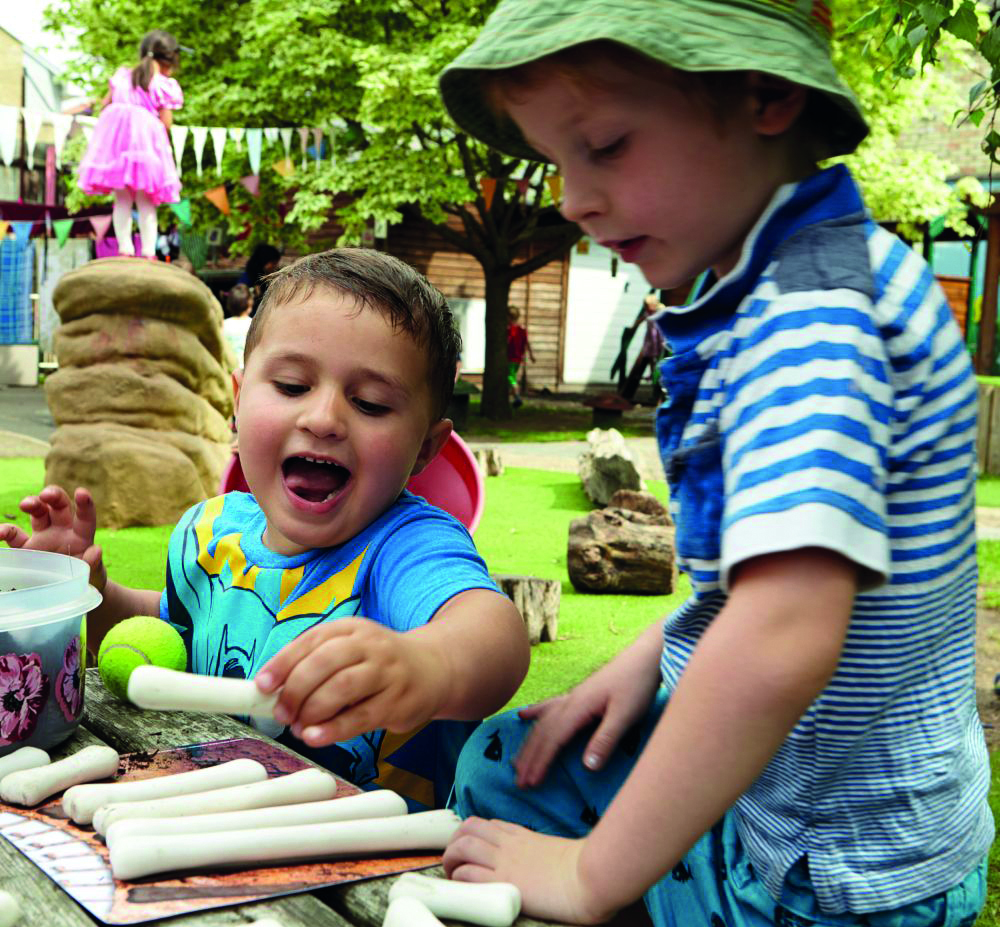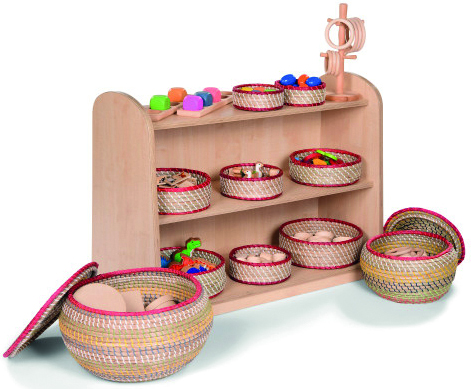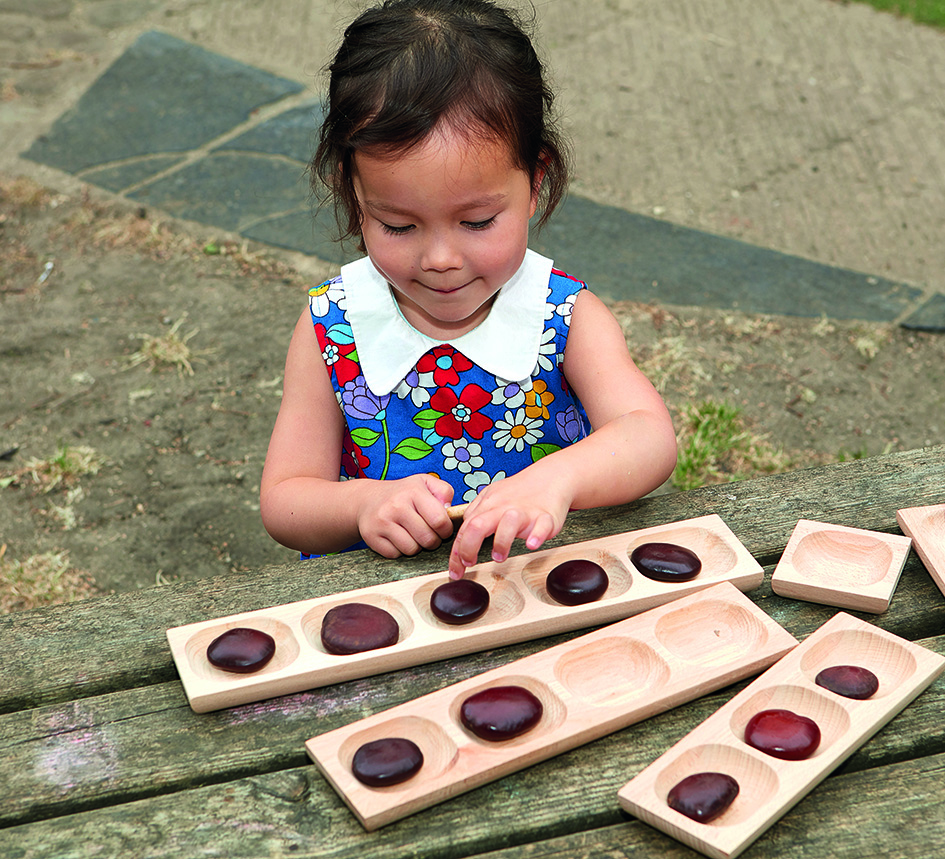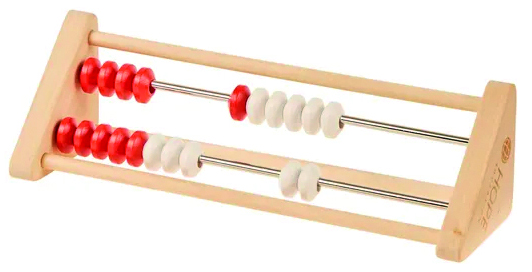
Maths possibilities are everywhere – in the water tray, the sand pit, loose parts play, storybooks and puzzles, block play and the mud kitchen. When interacting with these resources in meaningful ways, children can begin to explore mathematical concepts linked to number, quantity, shape and space. As Becky Francis, chief executive of the Education Endowment Foundation (EEF), outlines in Improving Mathematics in the Early Years and Key Stage 1, ‘Very young children are naturally curious, noticing differences in quantity and the shape of objects, and use early mathematical concepts when they play’ (see Further information).
Skilled practitioners can promote mathematics through spontaneous play and everyday routines and harness children’s early mathematical development by encouraging them to ‘have a go’ and not be afraid to make mistakes.
Early maths expert, author and consultant Elaine Taylor-Brown (formerly Bennett) advocates making maths ‘meaningful’ for young children, with plenty of ‘real-life’ problems to solve.
‘Measuring ingredients to make cakes or playdough, sorting the bricks in size and shape order or making sure everyone gets a share of the snacks on offer involves aspects of estimation, pattern prediction and seeing interlinked relationships, which are the core elements of maths,’ she explains.
ALL INCLUSIVE
 Although the Early years foundation stage (EYFS) statutory framework places a firm emphasis on number and counting, which it describes as the ‘building blocks’ that all children need to ‘excel mathematically’, Taylor-Brown stresses that maths is about ‘so much more than numbers’.
Although the Early years foundation stage (EYFS) statutory framework places a firm emphasis on number and counting, which it describes as the ‘building blocks’ that all children need to ‘excel mathematically’, Taylor-Brown stresses that maths is about ‘so much more than numbers’.
‘It’s about seeing patterns, making connections, creating and thinking critically,’ she explains.
Through junk modelling, for example, children learn to measure lengths of tape, select cereal boxes or milk cartons of varying shapes and sizes, and add items such as split pins to create rotating wheels for their models. Or in water play, they explore volume and capacity by filling up empty containers or buckets with water, seeing what happens when an object is dropped inside or counting how many scoops or bottles of water it takes to fill different containers.
‘The phrase “I wonder what would happen if?” should be commonplace in the nursery,’ explains Jude Twani, associate consultant for Early Excellence, as children and practitioners explore scenarios together that develop mathematical thinking and reasoning.
‘Notice the maths that’s taking place: the patterns children create, the way they arrange and sort resources, the language they use, the marks and drawings they make that reveal a mathematical understanding,’ she adds.
Practitioners can model mathematical talk by noticing and commenting on everyday interactions. For example, at lunchtime, ‘I took a bite out of my round cheese and it now looks like a moon.’ Or talking about the patterns that the clouds make in the sky, or the petals on a flower.
NUMBER AND COUNTING
Baby and toddler rooms should include a variety of resources that support children’s developing understanding of numbers and counting. Songs, rhymes and stories, such as Round and Round the Garden; Once I Caught a Fish Alive; Goldilocks and the Three Bears; and Three Little Pigs are some examples to use in daily routines.
Collections of interesting objects made from natural materials, such as cotton reels, spoons or scarves, will provide opportunities for babies to handle a selection of resources and test out their properties before moving on to organising, ordering, sequencing and classifying objects and quantities.
Loose parts – shells, pegs, cotton reels – used alongside boxes, tins, bottles or bags that toddlers can use to fill, empty, post and transport objects are a great start towards understanding numbers, counting and calculating.
Twani recommends cooking as an ‘effective way for understanding maths’. As children weigh out the ingredients, they learn about measuring, size and counting. Whereas Taylor-Brown says that outdoors is the ‘perfect place’ to explore maths on a ‘big, noisy, messy, multi-sensory, roofless, exciting level’.
‘Here, they can explore position, direction, speed, distance, measure, shape, pattern, space, movement and quantity in meaningful and purposeful contexts,’ she says.
Three- and four-year-olds enjoy counting out loud as far as they can go. At snack time, they can get involved in helping to cut up fruit and vegetables, counting and sharing it out fairly. There should be plenty of opportunities for children to see numerals as well as familiar maths images and tools in the environment. Practitioners can place clipboards, money, scales, calculators, clocks and timers in role-play areas and hang number ‘washing lines’ around the setting.



RESOURCES FOR MATHS
- Take maths outdoors with TTS’s Giant Outdoor Number Frames Silicone 10pk, £114.99, or its Wooden Rustic Number Stacker, £64.99. Or try TTS Messy Maths Potion Bottles, £24.99, in the mud kitchen. Hope’s Jumbo Number Pebbles, £29.95, are great for the water tray, and Agata’s Outdoor Maths from Cosy, £74.99, is good for counting and composition; or try Yellow Door’s Let’s Boost…Early Maths Outdoors Kit, £295, or its Dinosaur Bones Match and Measure resources, from £32.50.
- Store everything in Cosy’s Maths – Outdoor Counting Shed, £399, and decorate with Cosy’s Giant Number Bunting, £46.99.
- For loose parts, try Cosy’s Natural Sorting Set, £72.99, or its Complete Natural Treasure Collection, £239. TTS’s Metallic Elephant Number and Counting Set 1 – 10, £54.99, will engage those with schematic interests, or try TickIt’s Gem Cube Mirror Tray, £119.99 – great for pattern building – or its Wooden Sorter Vegetable Crates, £59.99. Try TTS Wooden Pattern Bricks 10pk, £69.99, or Hope’s Sorting and Counting Cans, £52.99, and its Maths Mastery Collection, £176.99. Or try Yellow Door’s 1,2,3,4,5-Frame Tray Set, £35.
- Alice Sharp’s Monster Maths Take Home Bags, £149.99, from TTS, contain activities for matching, size, pattern and opposites. Hope’s Rekenrek Counting Frame, £4.99, supports early counting, and its Counting Stories Book Pack, £89.99, is a great way to reinforce number recognition.
- For readymade maths areas, try Early Excellence’s Complete Maths Area 2-3 Years, £715, or its Maths Resource Collection 2-3 years, £295. Or support early investigation skills with its Maths Resource Collection 3-4yrs, £395, or the Complete Maths Area, £835.
CASE STUDY: Marcham Pre-school in Oxfordshire
Three- and four-year-olds at Marcham Pre-school have benefited from an evidence-based maths programme that has been shown to improve children’s attainment in maths by an additional three months – or up to six months for those on Early Years Pupil Premium.
Early Years Teacher Nicky Sanford signed up to the National Day Nursery Association’s Maths Champions programme in 2021 as one of 140 settings involved in a randomised controlled trial, funded by the Education Endowment Foundation (See Further information).
After undertaking the online training course to become the setting’s nominated Maths Champion, alongside her deputy manager, she says, ‘It’s changed our practice. We bring maths and questioning into everything we do.
‘One of the online training sessions was about composition. The activity suggestion involved giving children five multilink blocks and asking them to put them together in different ways. This really helped our children to approach early addition, as they began to realise that it didn’t matter which way you put them together – in columns or in the shape of a cross – you always ended up with the same composition.
‘Tidy-up time – or what we now refer to as stock-checking – has been revolutionised thanks to a simple change. We place an image of a resource onto the shelf and children match up the farm animals or the blocks of Duplo with the picture. In the home corner we have five hooks with five utensils, both numbered. Children match up the numbers and hunt around for the missing numbers.
‘We use a child-size abacus to register the children, with different colours to represent the four key groups. The children then count how many are in from the green or the blue group and we use that to compare which group has the most children.
‘Outdoors we use hoops with numbers inside and children throw the corresponding number of beanbags into the hoops. We also use the Community Playthings Outlast Blocks for directional activities where children make paths, describing the direction they take along the way. They use tape measures to find out the size of the missing piece of path.
‘We also play games with the children. The postman game is a favourite. Every child has a picture of a house with a number on it and when the postman pulls out a letter from the bag, the children work together to work out which house to deliver it to.’
Sanford says that the children have made ‘exceptional progress’ in their maths. ‘The Reception teacher was blown away by their level of maths and said that it was significantly higher than their peers.’
FURTHER INFORMATION
- Maths Champions (re-grant), EEF: https://bit.ly/450XC0G
- NDNA Maths Champions training: https://bit.ly/43AjxuI
- ‘Mathematical Musings’: https://bit.ly/43HLjpl
- Exploring Playful Mathematics podcast: https://bit.ly/3Of1uEW
- Early Childhood Maths Group: https://earlymaths.org
- EEF, Improving Mathematics in the Early Years and Key Stage 1: https://bit.ly/3KeWn6a









